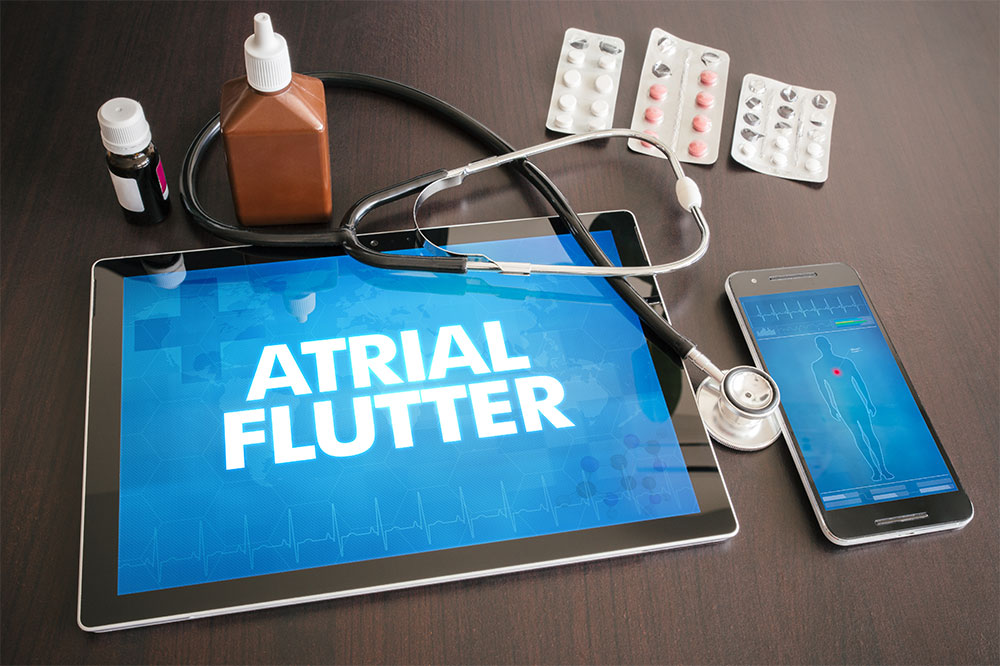
Atrial flutter – Its signs, causes, and management options
Atrial flutter is a health condition characterized by abnormal heartbeat or arrhythmia. A rapid electrical circuit in the heart causes the upper chambers (atria) to pump rapidly, impeding the ability of the heart to pump blood effectively. The condition is of utmost concern because it can significantly damage your heart muscle and increase the risk of stroke or blood clots if left ignored or untreated. Also, during the atrial flutter, the heart does not pump blood well into vital organs, such as the heart and brain, reducing or cutting off oxygen.
Understanding the signs and symptoms of atrial flutter
Atrial flutter is usually asymptomatic; some people cannot feel arrhythmia. However, in some cases, there can be palpitations or chest discomfort. Signs and symptoms of atrial flutter vary depending on ventricular rate and the nature of any underlying heart disorder. If the ventricular rate does not exceed 120 beats/minute and is regular, there will likely be few or no symptoms. Faster rates, exceeding 120 beats/minute, and variable Atrioventricular (AV) conduction usually cause palpitations and decreased cardiac output. This can also lead to more severe effects such as hemodynamic compromise (e.g., chest discomfort, dyspnea, weakness, syncope).
Some of the other symptoms of atrial flutter are:
- Racing heart (or heart beating too fast)
- Fatigue or tiredness
- Short of breath
- Chest pain
- Lightheadedness
The severity of symptoms of atrial flutter is high in people with underlying heart or lung disease. They may show severe symptoms during an episode of atrial flutter, such as;
- Angina pectoris (chest or heart pains)
- Feeling faint or light-headed
- Fainting (syncope)
What causes atrial flutter?
To understand the cause of atrial flutter, it is important to understand the heart’s anatomy. Our heart comprises four chambers – two on the top (atria) and two on the bottom (ventricles). When the heart is working fine, these four chambers of the heart contract and expand in an organized manner to pump blood through a system of blood vessels (circulatory system).
These contractions and expansion of heart chambers are directed by electric signals that indicate the heart to pump the right amount of blood for your body’s needs. The signals begin to generate from the area called the sinoatrial node or sinus node. SA nodes are responsible for controlling the heart rate and timing of heartbeats.
However, during an episode of atrial flutter, an abnormal electrical circuit forms inside the right atrium. This interferes with the normal contractions in the upper chambers. This new circuit leads to abnormal heart rhythm and rate. Eventually, the lower chambers of the heart (ventricles) also start beating fast, with the heart rate reaching 250-400 beats per minute (60-100 beats per minute is the normal rate).
Once the signals reach the AV node, it directs a bundle of cells in the upper wall of muscle between the ventricles to slow down the contractions, lowering the heartbeats to 150 and 75 beats per minute.
The term tachycardia refers to a condition where the heart beats abnormally. Since atrial flutter arises from an abnormality in the atria, it is called supraventricular (above the ventricles) tachycardia.
A disruption is signaled to the SA node can be due to the following :
- Heart valve disorders
- Heart condition present at birth
- Coronary artery disease
- High blood pressure
- Overactive thyroid
Managing atrial flutter
The treatment of Atrial flutter depends on the cause of the condition, symptoms, and risk for heart attack or stroke. Several prescription treatments can help treat atrial flutter. These prescription treatments have side effects; however, the benefits usually outweigh the risks. When prescription treatments don’t help, your healthcare provider may recommend a procedure that can help.
- Calcium channel blockers and beta-blockers slow down the heart rate.
- Antiarrhythmic treatments to treat abnormal arrhythmia.
- Blood-thinning medicines to help prevent stroke.
- Electrical cardioversion delivers quick, low-energy shocks to the chest to treat an abnormal and rapid heart rhythm.
- Catheter ablation – A minimally invasive procedure to identify and scare the small area or tissue causing atrial flutter.
Atrial flutter Vs. atrial fibrillation
Atrial fibrillation is also a type of atrial tachycardia, similar to atrial flutter. However, atrial fibrillation is a more chaotic rhythm and has more chances of developing a blood clot (or embolization). Both conditions carry an increased risk of stroke, so whether you have atrial fibrillation or atrial flutter, it is vital to be diagnosed early to get the right treatment and lower the risk of stroke or clot.
People with atrial flutter may not experience any symptoms. However, the fast pulse from atrial flutter can weaken your heart muscle, increasing the risk of stroke, heart failure, and other complications. Some effective treatments for atrial flutter include prescription treatment or minimally invasive procedures designed to cure the condition. And hence, staying cautious and alert about your heart health can help you manage the condition as early as possible.




